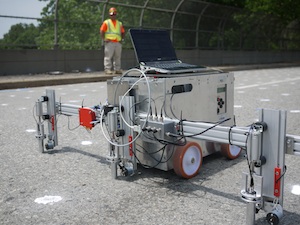A final report is pending on how technological advances can aid in the diagnosis, and ultimate rehabilitation, of the nation's vast bridge network, based on an exhaustive study led by Rutgers University in New Jersey, involving teams from three continents.


The U.S. system includes some 600,000 bridges. This number does not include signature structures such as the Golden Gate Bridge, but it includes all the nameless small overpasses and short-span structures most commuters rely on daily.
This March the Federal Highway Administration (FHWA) reported that one out of nine bridges, or close to 70,000 structures nationwide, are "structurally deficient." Fixing them, according to an FWHA study in 2009, is expected to cost $70.9 billion, but only $5.2 billion is available.
Since June 2010, the Rutgers' Center for Advanced Infrastructure and Transportation (CAIT) has been engaged in the International Bridge Study: a "round-robin" analysis of one nameless steel stringer bridge on Route 23 near Wayne, N.J.
The CAIT project invited teams with disparate approaches to diagnosis. It pinned the Americans—who have little time to give to any one individual bridge—against teams from Japan, where it's reasonable to spend two hours measuring just one bridge bearing, according to Dr. Franklin Moon, associate professor of Civil, Architectural, and Environmental Engineering at Drexel University.
Teams also came from Switzerland, the U.K., Austria, China, Korea and Canada. Up to 55 engineers worked on the project throughout the year, using Nondestructive Evaluation (NDE) methods, sensing technologies, information technology, and simulations.
The use of NDEs in particular can provide much better information at a significant reduction in cost, researchers say. The current method for testing for structural rigidity, for example, involves taking one to four drilled-out cylinders from the entire length of the bridge to a lab, and crushing them to measure the forces. A $30,000 machine can do 1,000 to 2,000 NDE samples in about half a day and eliminate the guesswork whether those 4 samples are indicative of the entire bridge, according to Dr. Nenad Gucunski, director of CAIT Infrastructure Condition Monitoring Program and chair of the Rutgers Dept. of Civil and Environmental Engineering.
The $100,000 "Stepper" allows testing for density inconsistencies inside decks through impact echo recording. The job is currently done by literally dragging a chain across the deck and listening for changes in echo, and by hammer-sounding. While no doubt cheaper, the chain method can not detect early deck delamination, not to mention the inaccuracy of the readings given traffic noise.

Post a comment to this article
Report Abusive Comment